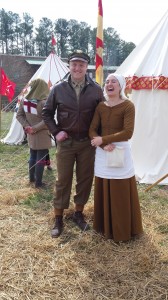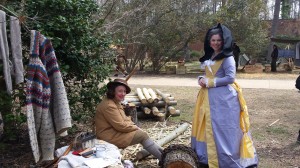I love the juxtaposition of historic values and modern settings. One of the reasons I write with vampires is the unique chance they give me to explore cultural shifts and changing social roles. In my book, Under a Blood Moon, I have two vampires, Jakob, born around 1360 and, Mark, born 1574. Jakob, a devout Catholic, values family and faith. Mark is more calloused and cynical. That’s probably enough to start writing but to really flesh out a character you need more. When you dig into the history you learn that most men in Jakob’s time couldn’t read. They knew famine personally and would have lost family members to starvation. Their church offered not only solace but also support and safety. Knowing that about him improves my writing. There’s no way around it, to really understand how historic characters think you need to do research.
While I enjoy the usual kinds of research, like reading academic articles and history books, my favorite kind of research is more hands on. I talk with and interview historic reenactors. Most people are familiar with Civil War reenactors. Many Southern states hold large scale battles and encampments in the summer. But there’s more than just the Civil War out there. In St. Augustine, where I went to college, encampments from the 16th century were common. I spent more than one summer night awkwardly pressed in a crowd of women and children forced into the old fort while cannons fired around me, trying to beat back English forces as if it was still 1586. For years I interacted with people who slept, ate, and dressed in that time period. It’s no surprise that I based Mark on what I learned. His favorite breakfast is the one I saw being eaten in the camps, his political views are shaped by the discussions I had with the reenactors while they ate.
I was recently lucky enough to find an event that focused not on one battle or time period, but brought them all together. Military through the Ages showcased encampments from a Roman Legion (64 A.D.) to the current Virginia Army National Guard. While it was hard to pull myself away from the Fenvald Vikings, the good people of La Belle Compagnie who reenact the Hundred Years War between England and France (1337 to 1453) were my best resource of the day. I learned about cooking, cleaning, women’s roles vs. men’s roles, and how fighting really worked in the time period. Reading about swords is good, holding the sword and talking to someone who uses period techniques to make swords is even better.

The event included a lot of hands on demonstrations, some of them given by people who aren’t just reenacting, but remembering. This lovely woman was a member of British Women’s Land Army during WWII.
The Women’s Land Army took on the jobs left empty by soldiers. They planted and harvested crops, milked cows, and ran the home front. Despite all this, I’d never heard of them. I folded their story into the background of Margaret, Jakob’s love from the 1940s and the grandmother of his adopted son. Not far from the encampment, one of the wonderful women offered to pin my hair up. While Margaret and I don’t have the same hair, I know the way the bobby pins scraped across my scalp will end up in a book somewhere.

To me history is a dying solider on a battlefield telling you his story. Reenactments give us a chance to talk to those soldiers, and ask them about the little things we might not be able to read about so easily. When you’re lucky you get a chance to feel a piece of history (or something pretty close) for yourself.